Explore the vibrant world of Cat Tien National Park, where the symphony of Tokay Gecko and the subtle movements of snakes create a thrilling backdrop for herping adventures. Herping in Cat Tien National Park from the Cattien Bent-toed Gecko to the imposing King Cobra, this forest is a haven for reptile enthusiasts. Uncover five essential hacks to navigate the night, decode distinctive calls, and make your herping expedition in Cat Tien unforgettable. Join us as we unravel the mysteries of this biodiverse landscape, ensuring every step is a triumph over the potential hiss-stakes of the wild.
Herping in Cat Tien National Park
Herping, the art of seeking and observing reptiles and amphibians, finds a perfect backdrop in Cat Tien National Park. Located in the southern region of Vietnam, spanning across Lam Dong, Dong Nai, and Binh Phuoc provinces, the park covers an area of 71,920 hectares. Its diverse habitats, from lowland grasslands to lush Dipterocarp forests, make it a prime location for this fascinating pursuit.
The park’s hot and humid climate, with daytime temperatures often surpassing 30°C and cooler nights around 22°C, combined with a monsoon season, fosters an environment teeming with diverse species. For herpers, Cat Tien presents an exciting opportunity to witness a wide range of reptiles and amphibians in their natural habitat.
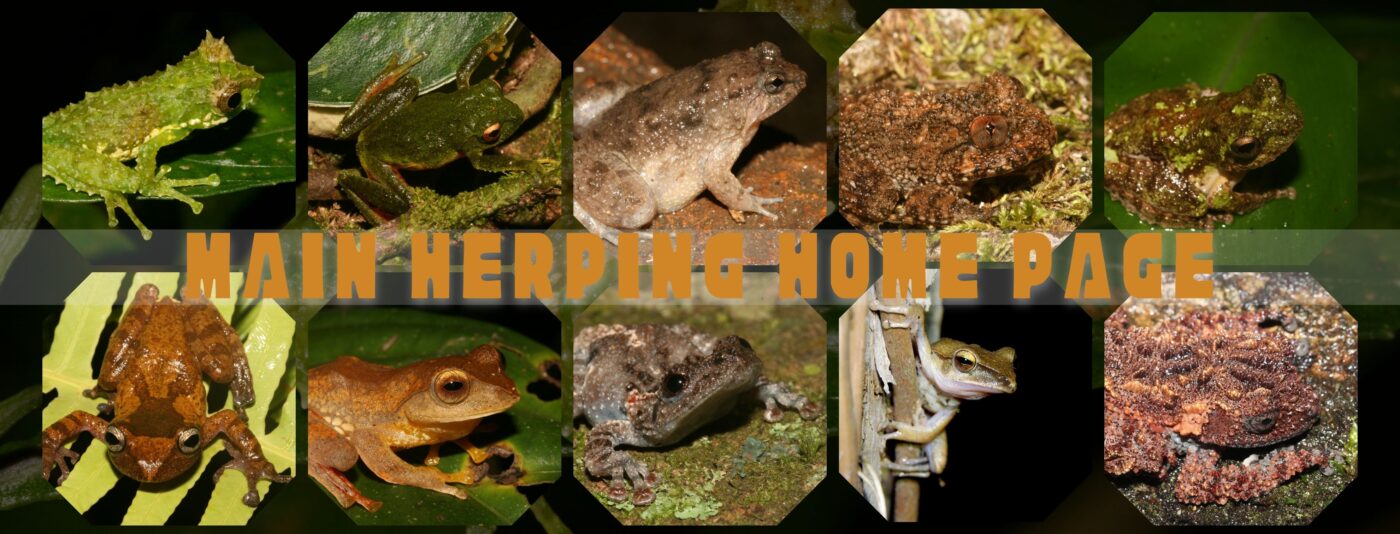
Despite the challenging climate, Cat Tien National Park boasts an extraordinarily rich biodiversity, housing between 130 to 150 reptile and amphibian species, including 6 endemic species. This lowland forest becomes a haven for herpetological enthusiasts, offering a unique opportunity to witness the intricacies of life adapted to these extreme conditions. Join us in the pursuit of herping in Cat Tien, where every step unravels the mysteries of this thriving ecosystem, making it a remarkable experience in the world of reptiles and amphibians.
Where to find them?
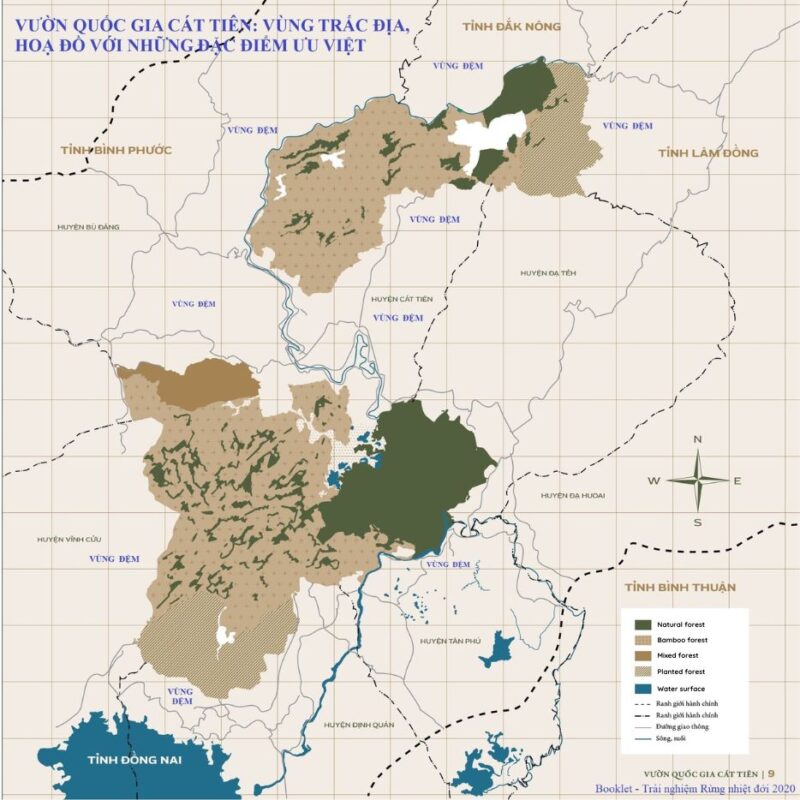
This photo captures the diverse habitats of Cat Tien National Park, showcasing five distinct landscapes. The natural forest, untouched and varied, hosts a range of amphibians and reptiles. Bamboo forests provide shelter, especially for larger species like the King Cobra. In mixed forests, diverse flora supports various amphibians and reptiles.
Unfortunately, human-influenced areas appear less hospitable. The planted forest, a conservation effort, nurtures specific species strategically. Water surfaces are bustling hubs for amphibians and reptiles, with the largest communities found in natural forests and near water. This snapshot reveals Cat Tien National Park’s array of ecosystems, each vital to its extraordinary wildlife.
Herping Guide in Cat Tien National Park

This photo features 15 accessible spots within the park, ideal for those honing their reptile and amphibian spotting skills. Most locations are best explored in the morning since herping is restricted after 6 pm due to park regulations. However, certain places offer guided tours with service cars and rangers, available by permission from the park headquarters or with a tour guide. These areas, teeming with various reptiles such as tortoises, geckos, vipers, cobras, and monitors, come alive at night throughout the year, including the rainy season. Noteworthy spots to explore include:
Crocodile Lake
This iconic spot is home to the last community of Siamese Crocodiles in Vietnam. Venture along the Crocodile trail surrounding the lake, revealing around 50 species, including intriguing reptiles like tortoises and terrapins. The nocturnal setting enhances the thrill of herping, making it a must-visit for wildlife enthusiasts.
Uncle Dong Tree and Hundred-trunked Ficus
These two locations offer captivating landscapes for herping enthusiasts. Renting a car for exploration is an option, allowing you to navigate through areas where reptiles and amphibians thrive. Be sure to inquire about any regulations beforehand to ensure a smooth and enjoyable experience.
Heaven Rapid
For those seeking an undisturbed haven, Heaven Rapid stands as a secluded area with minimal human impact. This pristine environment becomes a nocturnal paradise, providing a unique opportunity for reptile and amphibian searches. While entry is limited, the chance to explore this untouched landscape is well worth the effort.
Surrounding Campsite
Although not the most recommended spot, the area surrounding the Campsite may unveil encounters with small vipers. Occasionally, luck may grant you a sighting of a tortoise. While the Campsite may not boast the diversity of other locations, it still offers a chance for modest herping experiences.
Each of these destinations within Cat Tien National Park unfolds its distinct charm, inviting enthusiasts to embark on unique herping adventures amidst the park’s diverse ecosystems.
15 Herp Highlight species in Cat Tien National Park
Cat Tien National Park stands as a biodiversity hotspot, particularly when it comes to the realm of herpetofauna. With estimates ranging from 130 to 150 species of reptiles and amphibians, this ecological haven paints a vibrant tapestry of diverse life. The park’s ecosystems host an array of captivating species, from the endemic Tiny Narrow-Mouth Frog (Microhyla minuta) to the Siamese Crocodile (Crocodylus siamensis).
Despite its rich diversity, it’s noteworthy that the nearest articles currently account for only around 80 species. This underscores the depth and complexity of Cat Tien’s herpetological landscape, suggesting that there might be undiscovered species or variations yet to be documented. As the park continues to unveil its secrets, researchers and enthusiasts alike are drawn to this thriving ecosystem, each visit offering the potential to unearth new facets of its remarkable biodiversity.
Amphibian
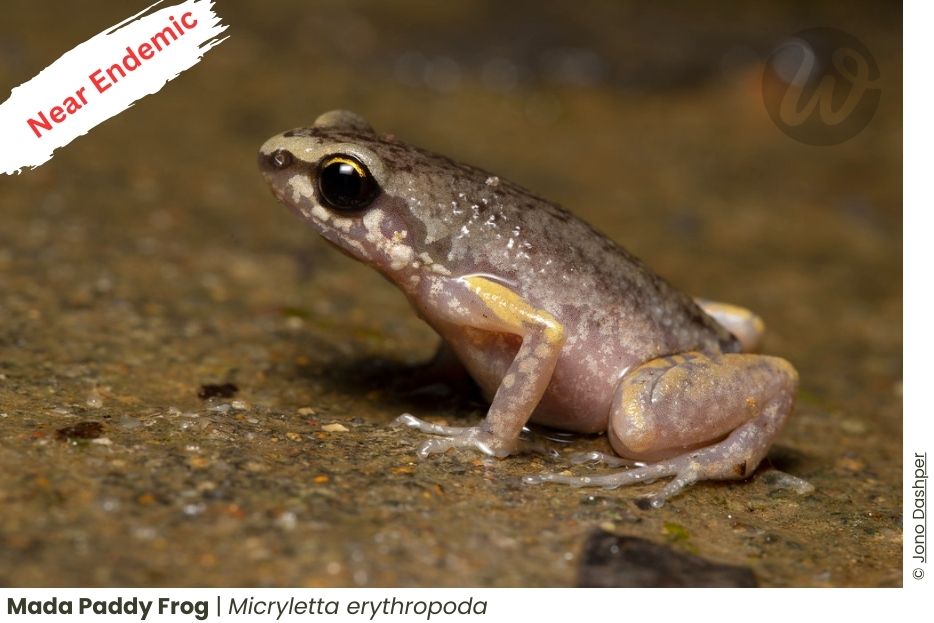
(Near Endemic) Micryletta erythropoda (Tarkhnishvili, 1994) — Mada Paddy Frog: Explore the habitat of the Near Endemic Mada Paddy Frog, a remarkable amphibian within the park.
(Endemic) Microhyla minuta (Poyarkov, et al., 2014)– Tiny Narrow-Mouth Frog: Encounter this endemic amphibian, the Tiny Narrow-Mouth Frog, showcasing its petite yet captivating presence.
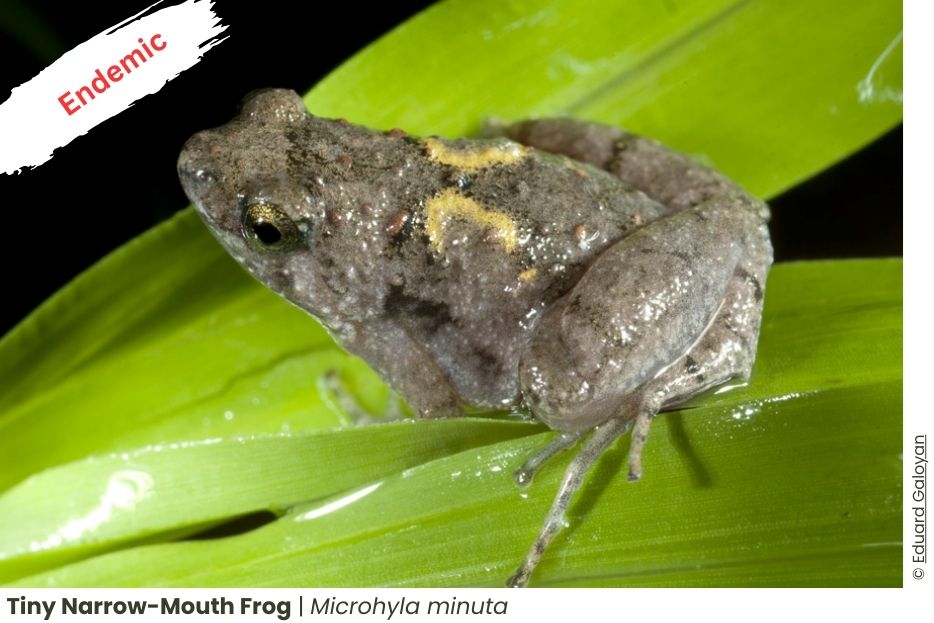
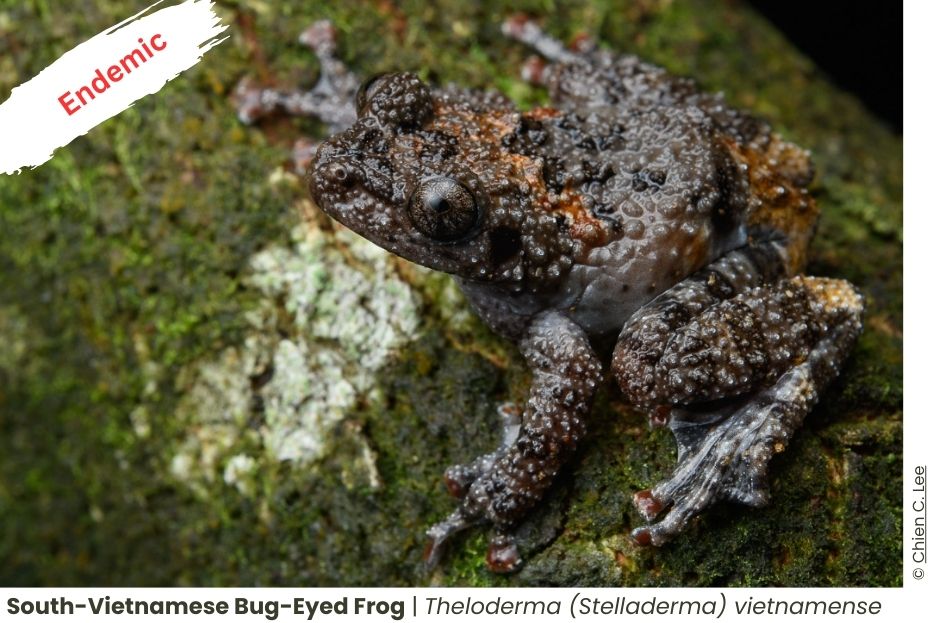
(Endemic) Theloderma (Stelladerma) vietnamense (Poyarkov, et al., 2015) – South – Vietnamese Bug-Eyed Frog: Discover the Vietnamese Bug-Eyed Frog, an endemic species with distinctive features, adding to the park’s unique biodiversity.
(Endemic) Ichthyophis catlocensis (Geissler, et al., 2015) — Cat Loc Caecilian: Uncover the secrets of the Cat Loc Caecilian, an endemic amphibian, as it navigates its underground habitat.
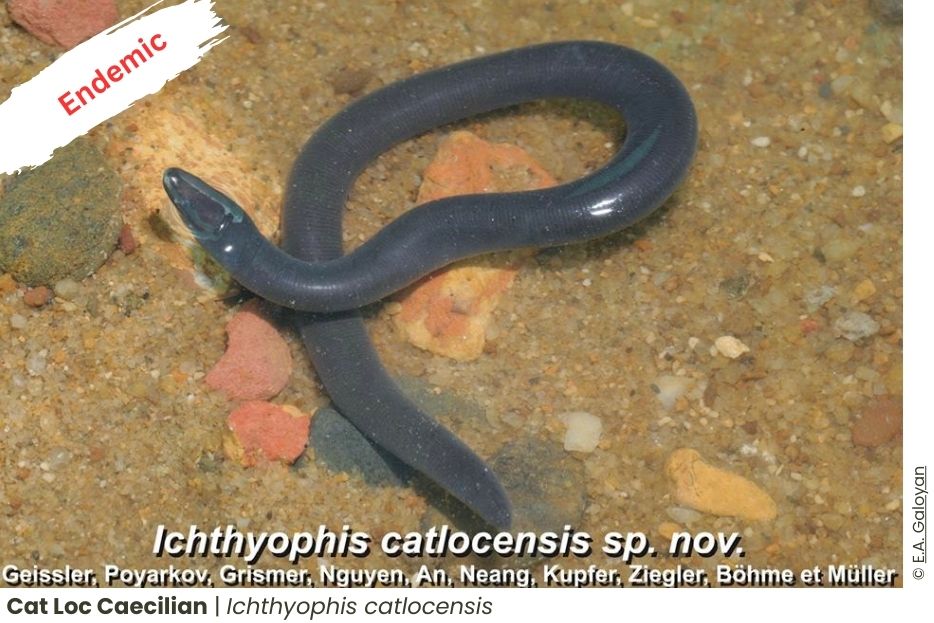
Reptile
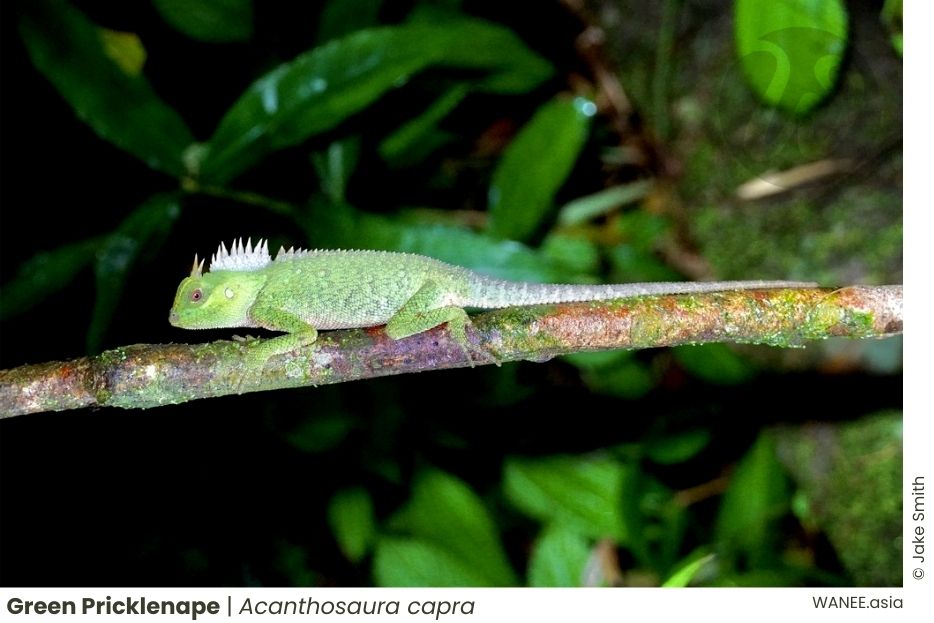
Acanthosaura capra (GÜNTHER, 1861)— Green Pricklenape: Witness the Green Pricklenape, a reptilian marvel showcasing its distinctive features in the diverse landscapes of Cat Tien.
Draco maculatus ((GRAY, 1845) — Spotted Flying Dragon: Observe the Spotted Flying Dragon as it gracefully glides through the air, adding a touch of magic to the park’s reptilian spectacle.
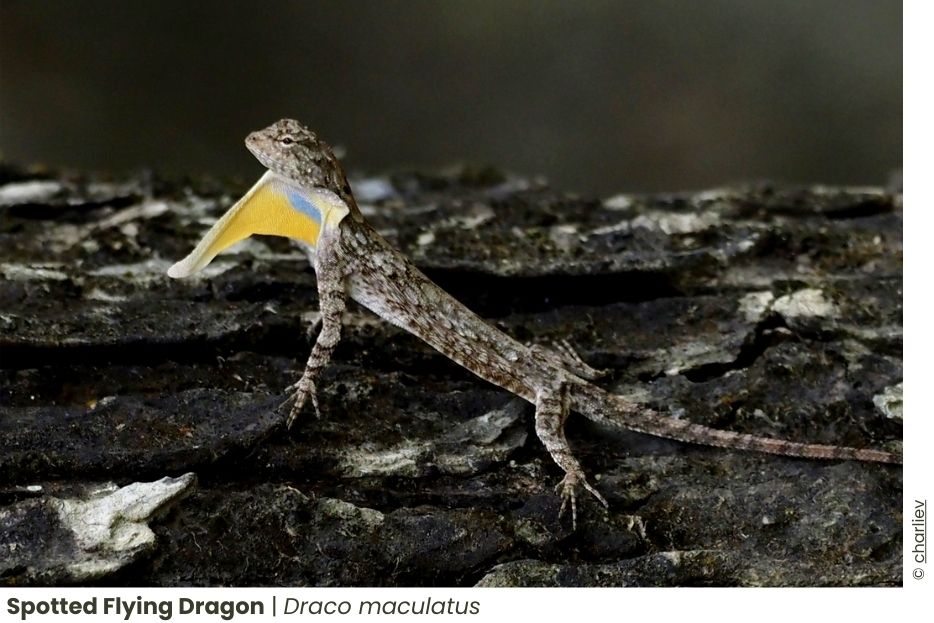
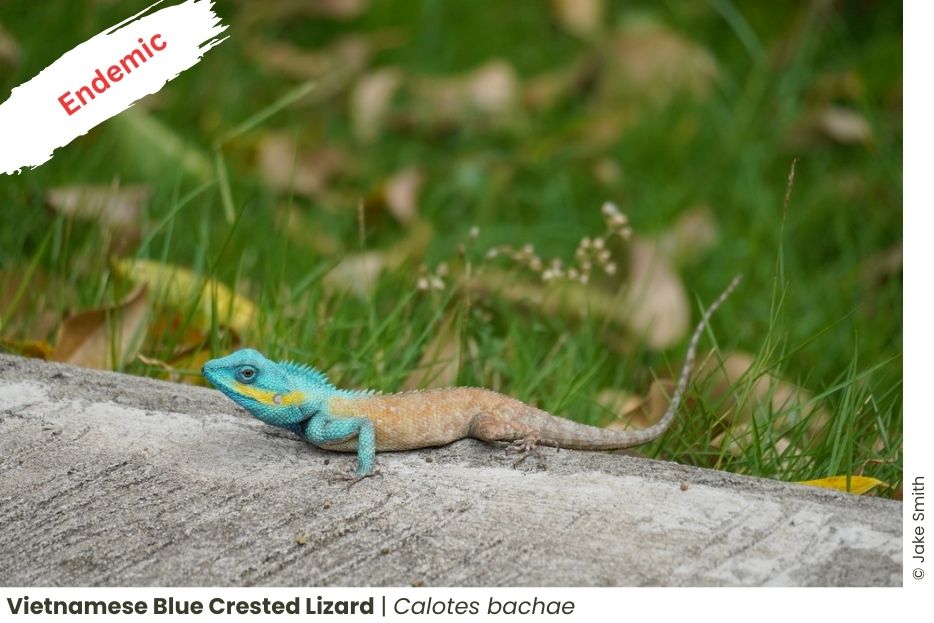
(Endemic) Calotes bachae (Hartmanm, et al., 2013)— Vietnamese Blue Crested Lizard: Encounter the Vietnamese Blue Crested Lizard, an endemic species proudly displaying its vibrant colors in the park.
Cyrtodactylus cattienensis (GEISSLER, et al., 2009) — Cat Tien Bent-toed Gecko: Discover the Cat Tien Bent-toed Gecko, an endemic gecko species perfectly adapted to the park’s unique environments.
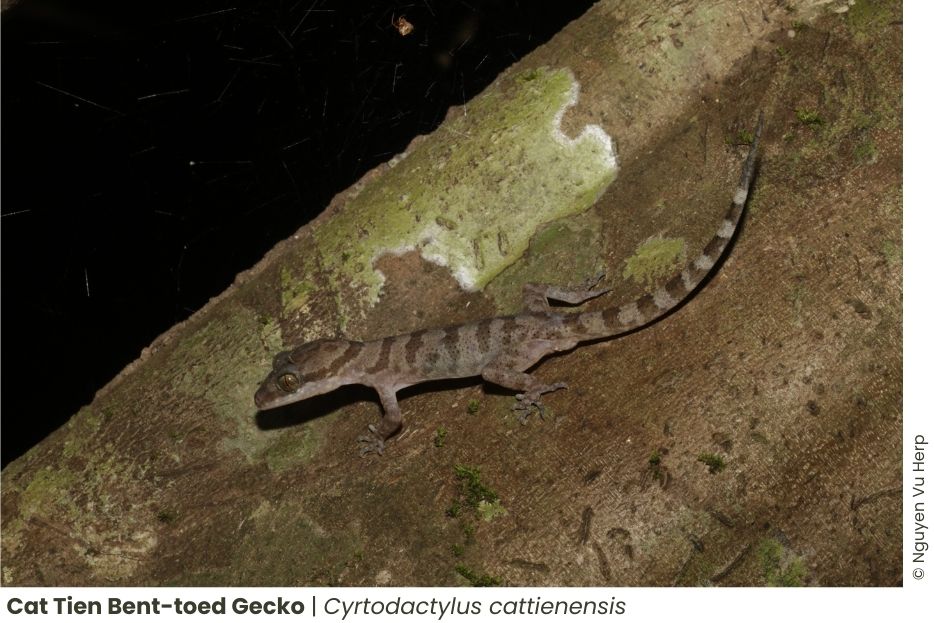
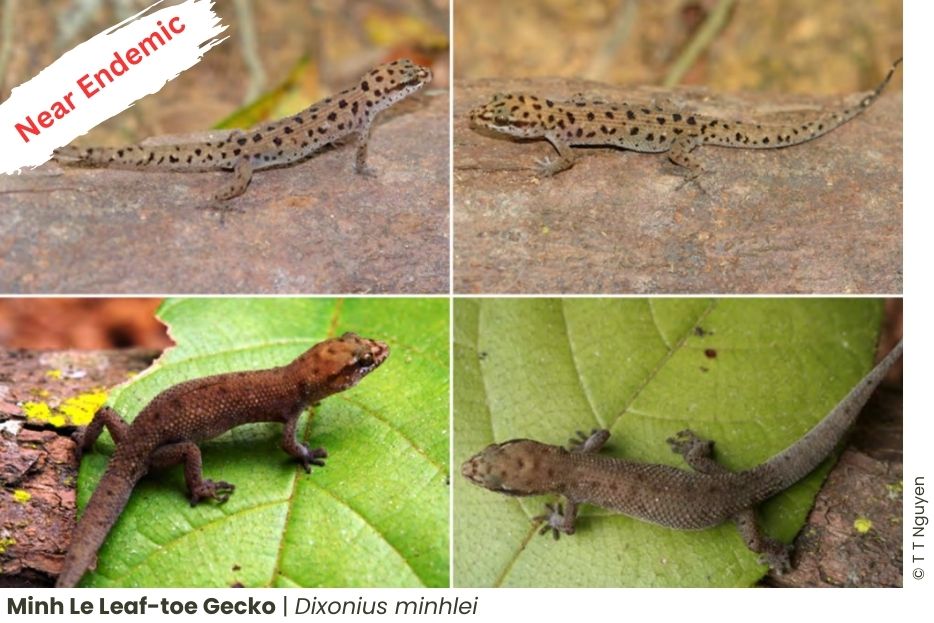
(Near Endemic) Dixonius minhlei (ZIEGLER, et al., 2016) — Minh Le leaf-toe gecko: Spot the Minh Le leaf-toe gecko, a near-endemic species showcasing its remarkable leaf-like adaptations.
(Endemic) Hemiphyllodactylus cattien (YUSHCHENKO, et al., 2023) — Cat Tien Slender Gecko: Marvel at the Cat Tien Slender Gecko, an endemic species perfectly suited to the park’s diverse ecosystems.
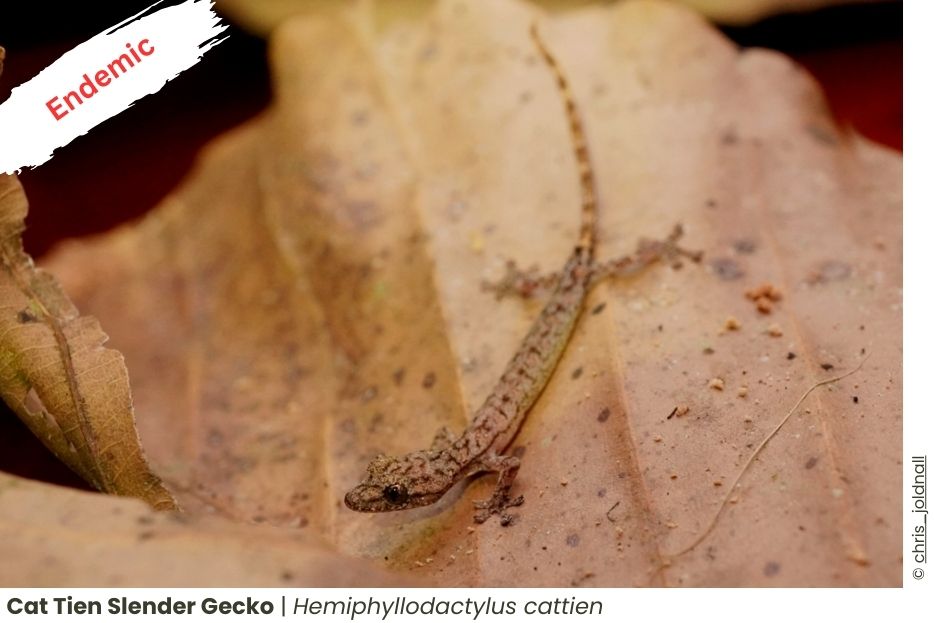
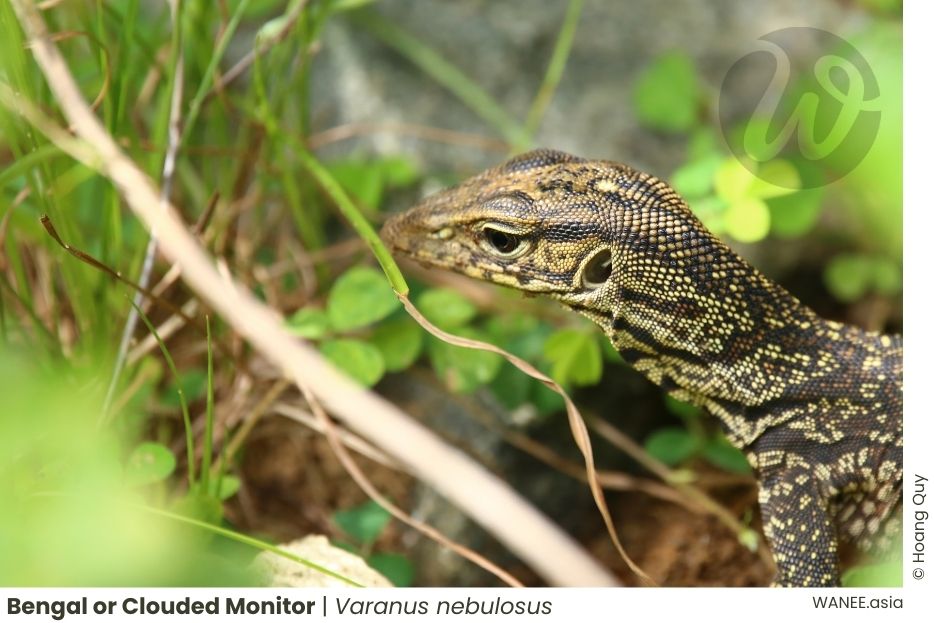
Varanus nebulosus (GRAY, 1831)— Bengal or Clouded Monitor: Witness the impressive Bengal or Clouded Monitor, a reptile that adds a touch of grandeur to the park’s wildlife.
(Endemic) Oligodon cinereus (GÜNTHER, 1864) — Ashy Kukri Snake: Encounter the Ashy Kukri Snake, an endemic species slithering through the park’s underbrush.
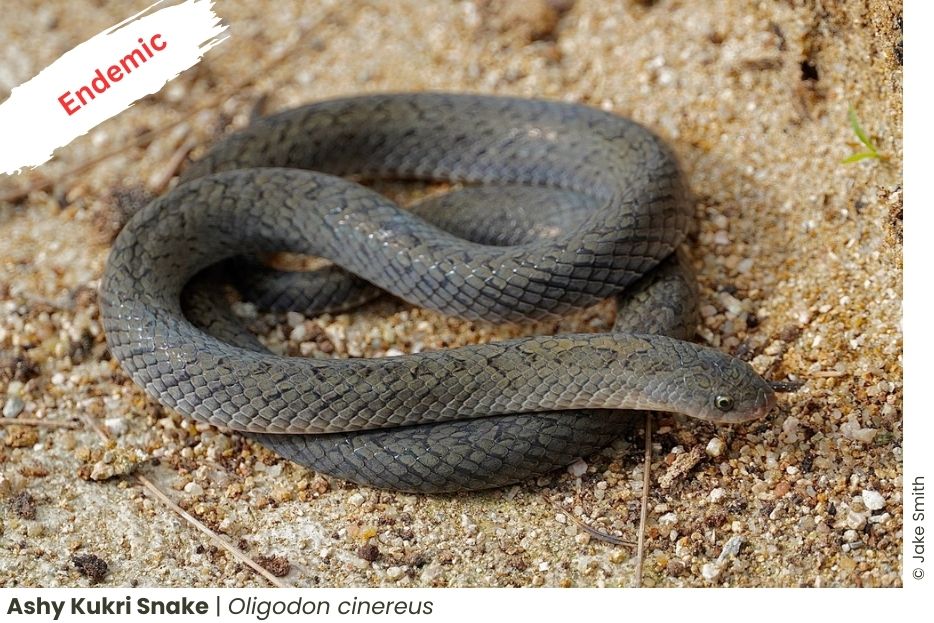
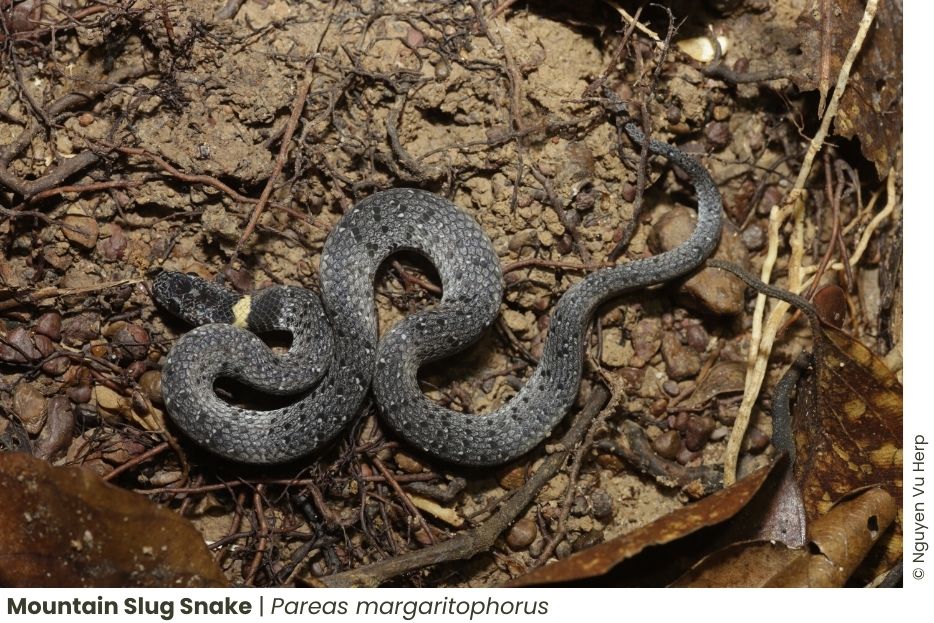
Pareas margaritophorus (JAN, 1866) — Mountain Slug Snake: Explore the habitats where the Mountain Slug Snake gracefully moves, showcasing its slender form.
Trimeresurus rubeus (MALHOTRA, et al., 2011)— Ruby-eyed Green Pitviper: Beware the presence of the Ruby-eyed Green Pitviper, a venomous beauty that adds a touch of danger to the park’s reptilian realm.
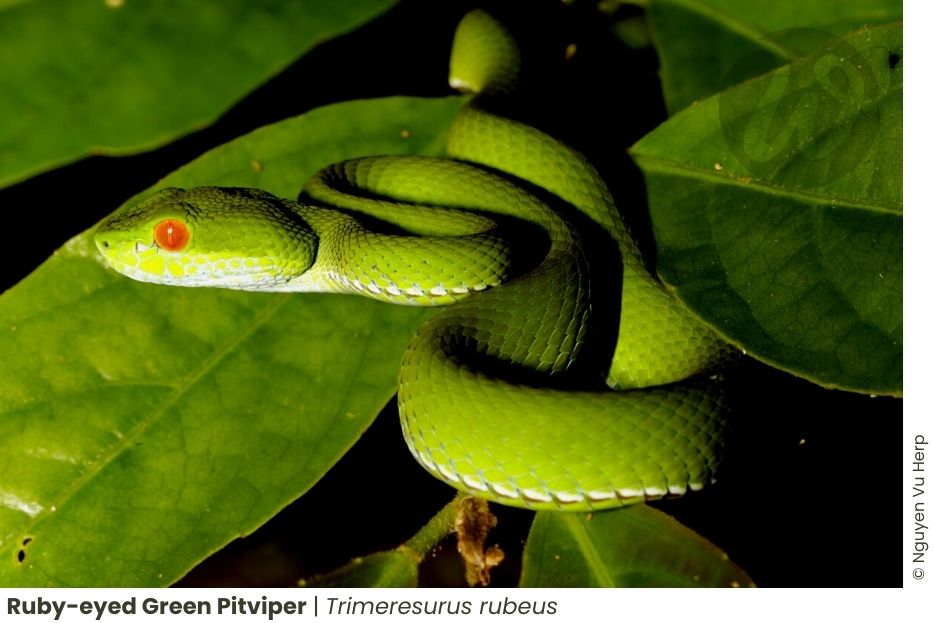

Crocodylus siamensis (SCHNEIDER, 1801)— Siamese Crocodile: Experience the magnificence of the Siamese Crocodile, a species contributing to the park’s aquatic biodiversity.
When is the most suitable time for herping in Cat Tien?
Cat Tien, situated within a Tropical monsoon climate, boasts a consistent high humidity level, exceeding 80%, making it an ideal environment for the thriving amphibian and reptile populations. The region experiences two distinct seasons: the dry season, characterized by minimal rainfall, and the rainy season, marked by steady and rejuvenating rains. Notably, the dry season rarely witnesses rain, while the rainy season unfolds gradually, providing essential moisture for the park’s diverse wildlife.
Late April to November emerges as the prime period for herping enthusiasts, aligning with the onset of the rainy season. This timeframe is particularly noteworthy as it coincides with heightened activity among reptiles and amphibians. The increased humidity and rainfall during this period contribute to the robust growth and mating behaviors of these fascinating creatures.
It is during this time that the park comes alive with the vibrant calls of amphibians and reptiles, presenting a captivating opportunity for enthusiasts to witness mating rituals, egg-laying, and other pivotal moments in their life cycles. The synergy of environmental conditions and the creatures’ behaviors makes this season an optimal window for herping adventures in Cat Tien National Park.
Notably, even during the dry season, when rainfall is scarce, the park remains a haven for herping. The diminished need for raincoats makes it an opportune time to explore, particularly for those seeking encounters with snakes, pythons, and tortoises. The dry season, while less damp, doesn’t diminish the vibrancy of Cat Tien’s herpetofauna, offering enthusiasts a remarkable spectrum of experiences year-round.
Diverse Tours to Explore Cat Tien National Park’s Reptilian
Conclusion
Embarking on the enchanting journey of herping in Cat Tien National Park unveils a world of biodiversity that captivates the senses. The park, nestled within a Tropical monsoon climate, provides a haven for reptiles and amphibians, boasting a constant humidity level above 80%. Whether navigating the dry season, with its minimal rainfall, or immersing in the rejuvenating downpours of the rainy season, each moment offers a unique encounter with the diverse herpetofauna.
Late April to November emerges as the prime window for herping enthusiasts, coinciding with heightened activity among reptiles and amphibians. The onset of the rainy season amplifies their robust growth and vital mating behaviors, creating a symphony of calls that echoes through the park. Notably, even during the dry season, the allure of Cat Tien prevails. The reduced need for rain gear opens up opportunities to explore, particularly for those seeking the elusive snakes, pythons, and tortoises that call the park home.
In essence, herping in Cat Tien National Park transcends the conventional boundaries of exploration, offering a dynamic and immersive experience year-round. Whether under the gentle drizzle of rain or beneath the clear skies of the dry season, the park’s herpetofauna, from the enchanting Tiny Narrow-Mouth Frog to the majestic Siamese Crocodile, creates a tapestry of life waiting to be discovered.
As enthusiasts tread through the diverse habitats, from Crocodile Lake to the secluded Heaven Rapid, the park’s rich biodiversity unfolds, inviting adventurers to witness the fascinating intricacies of nature in its most primal form. Herping in Cat Tien National Park, with its ever-changing seasons, is a journey into the heart of a vibrant ecosystem, a celebration of life that echoes through every rustle of leaves and every elusive call in the night.



Crocodile Trail – The Best Birding Trail in Cat Tien National Park
If you’re a birder or nature photographer planning a trip to Vietnam, few places offer [...]
Cong Troi Trail – Top 1 Dalat Plateau Birding Trail Experience
If you’re a birder or nature photographer planning a trip to Vietnam’s Central Highlands, the [...]
How to Identify the Greater Sand Plover, Tibetan Sand Plover and Siberian Sand Plover
ContentsHerping in Cat Tien National ParkWhere to find them?Herping Guide in Cat Tien National Park15 [...]
Highlights of Cat Tien National Park Reptiles and Amphibian Endemics
Spanning over 71,350 hectares of tropical forests, grasslands, and wetlands, Cat Tien National Park is [...]
Highlights of Cat Tien National Park Mammals in a World Biosphere Reserve
In addition to reptiles and birds, Cat Tien National Park is also rich in mammals, [...]
Kontum Plateau Endemic and Highlight bird
Kontum Plateau Endemic And Highlight Bird species like Chestnut-eared Laughingthrush and top birding routes while [...]